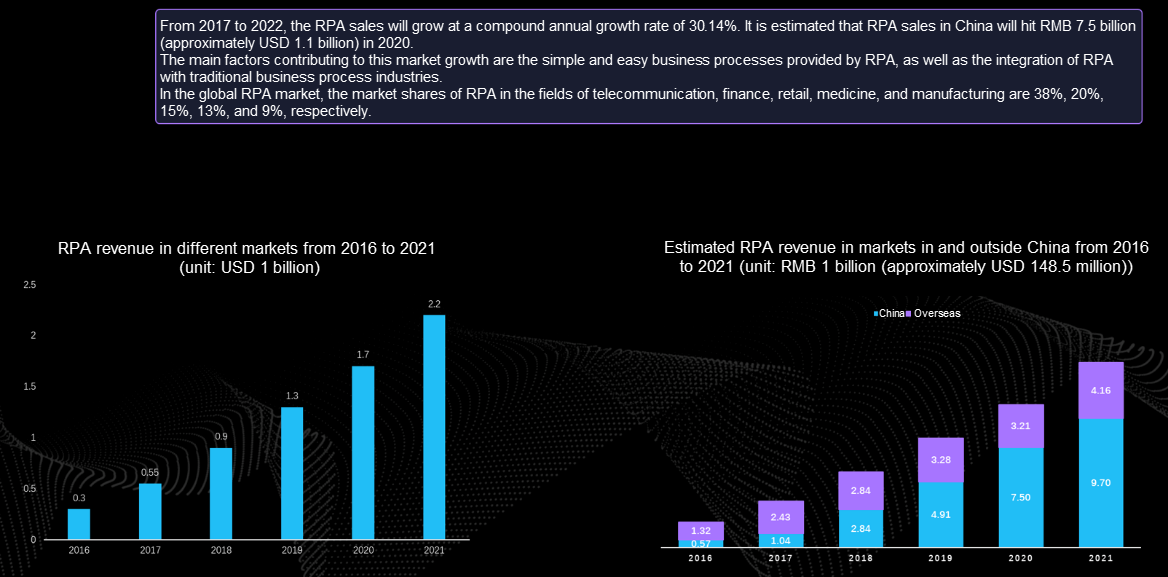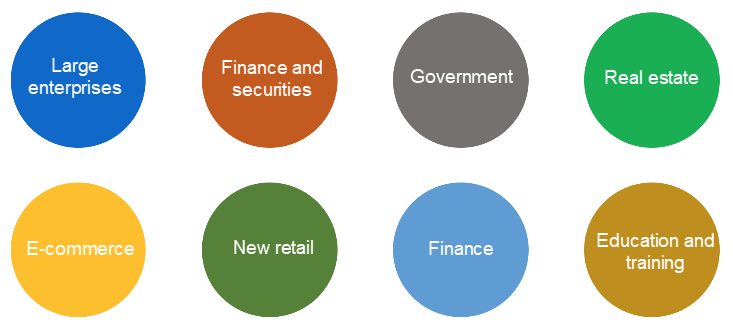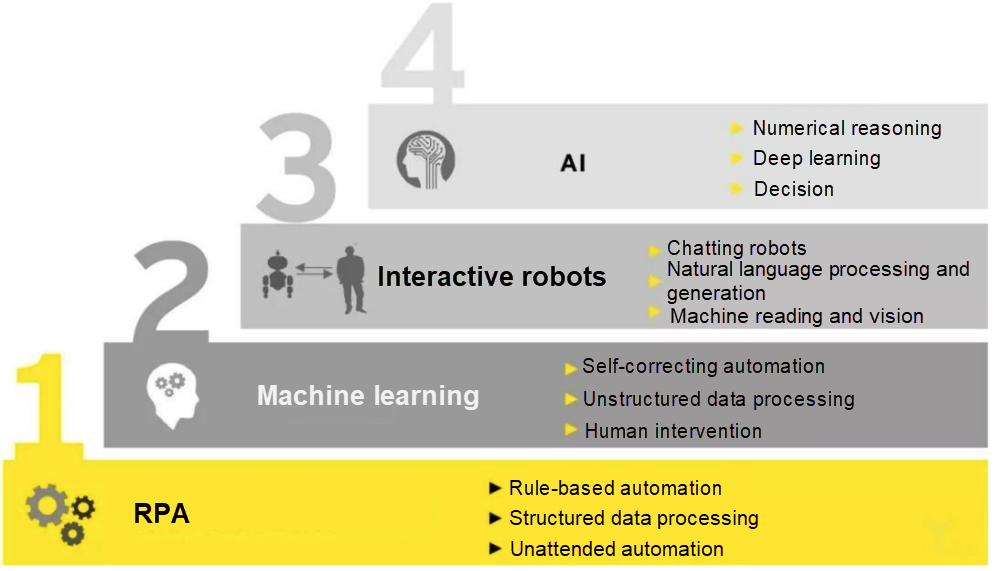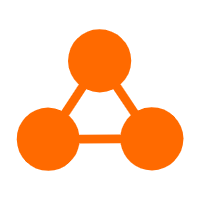By Yanmin
This article is one of a series of lectures on Alibaba Cloud robotic process automation (RPA). It describes the development and main scenarios of RPA, mainstream RPA vendors in and outside China, and the prospects of RPA.
According to Gartner's latest research, the total RPA software spending in the world will reach USD 680 million (a year-on-year increase of 57%) in 2018 and USD 2.4 billion in 2022.
Cathy Tornbohm, Vice President of Gartner, said, "End-user organizations use RPA technology as a fast and easy way to automate manual tasks. Some employees continue to do routine tasks that require them to manually cut, paste, and modify data. When RPA tools are used to perform these operations, the error rate is reduced and the data quality is improved."
Nowadays, RPA is mostly applied to sectors such as e-commerce, finance/taxation, banking, manufacturing, new retail, insurance, logistics, government, and public security. According to Tornbohm, "It is generally difficult for these organizations to integrate different elements such as finance and HR systems. They are turning to RPA to automate existing manual tasks and processes, or traditional system functions."
RPA tools use multiple interactive user interface (UI) description technologies to simulate the "manual" paths used by employees to complete their tasks. Currently, a wide range of solutions are available for trial use. Multiple RPA tools can run on a single desktop computer or enterprise server.

According to Gartner, 60% of enterprises and organizations with revenue over USD 1 billion will deploy RPA tools by the end of 2018. By the end of 2022, 85% of large and ultra-large organizations will deploy RPA tools in one way or another. Tornbohm said, "By 2019, as RPA technology is deployed by more enterprises and brings more benefits, such as lower costs, higher accuracy, and better compliance, the average price of RPA will be reduced by 10% to 15%."
At present, the RPA technology is increasingly sophisticated in and outside China. With this technology, enterprise employees can develop RPA robot applications that capture existing applications to process transactions, control data, and communicate with other information systems. Any repetitive work that consumes a lot of manpower can now be completed by RPA robots, which saves on manpower, money, and time. Like the industrial robots that enhanced and transformed the manufacturing industry by improving productivity and quality, RPA robots are revolutionizing our management of service processes, including workflows, remote infrastructure, and background operation methods. They significantly increase the work accuracy, reduce the work time, and improve the transaction efficiency of enterprises.
RPA is applicable to scenarios that meet two requirements: a large amount of repetitive work (making RPA necessary) and explicit rules (making RPA possible). On this basis, RPA robots can be applied in many industries and service scenarios, for example:


(1) Blue Prism
Blue Prism (BP) is the pioneer of the RPA field and is the first company to propose the concept of RPA. BP is a multinational software company founded in the UK in 2001 and has over 200 customers all over the world. It has been recognized by Gartner, an American IT research and consulting company, and has cooperated with giants such as NHS, Accenture, Hexaware, Hewlett Packard, Capgemini, and IBM. Currently, BP has upgraded its RPA products to Version 6 and continuously integrates RPA products with the lasted AI products.

(2) UiPath
UiPath is a global software company founded in 2005 that is committed to developing the RPA platform. It is a unicorn in the RPA field. UiPath has cooperated with companies such as SAP, EY, J.P. Morgan, Deloitte, Accenture, Capgemini, and the BBC. UiPath provides the following three RPA products:

(3) Automation Anywhere
Automation Anywhere (AA) is currently the most powerful RPA vendor with the largest range of users. It provides powerful and user-friendly RPA tools that can process complex tasks. AA has cooperated with companies such as EMC2, KPMG, Deloitte, Accenture, Genpact, and Infosys. In July 2017, IBM and AA announced a joint initiative to help enterprises simplify their operations and deliver IBM RPA and BPM.

(4) NICE
NICE is a leading RPA solution provider and has created some influential success stories. Its official website offers many white papers and high-quality RPA-related blogs, allowing you to learn more about NICE's RPA services and use cases.

(5) WorkFusion
WorkFusion is a software company dedicated to the development of AI software to transform our work patterns. Headquartered on Wall Street, WorkFusion has branches in India, the United States, and Europe. Its main businesses include RPA, AI, and cognitive automation.

(6) i-Search
Established in 2011 and headquartered in Shanghai, i-Search is a software manufacturer that offers i-Search Robotic Process Automation (iS-RPA) products, User and Entity Behavior Analytics (UEBA), and Counter Service Monitor (CSM) solutions. It provides customers with services, such as cross-platform integration of enterprise internal data, cloud security management, big data security analysis, user behavior collection and analysis, auditing of application operation screen recording, visual quality inspection of customer service behavior, and monitoring and analysis of bank counter transactions.

(7) Alibaba Cloud RPA
Developed in 2011 based on the Alibaba Group Taobao platform, Alibaba Cloud RPA empowers the internal functional modules of Alibaba Group, such as Tmall, Taobao, Fliggy, Cainiao, Ant Financial, and the financial department. It received the Taobao Innovation of the Year Award and the Special Contribution Award of Alibaba Group. Since its official launch in 2016, Alibaba Cloud RPA has provided industry solutions in multiple fields, including e-commerce, finance, manufacturing, and government, improving efficiency by 500% on average. Alibaba Cloud RPA Version 3.0 has already been released. Built on the Python development engine, Alibaba Cloud RPA (V3) provides a powerful control recording function, a wide range of SDKs, and more private data security measures. It has its own unique advantages in Office-related controls.
The future has come. As a software-based robot that uses sophisticated AI technologies to simulate a human being, an RPA robot has its own "eyes", "ears", "hands", "mouth", and "head" that function as follows:
As these individual technologies become more and more sophisticated, RPA robots will be able to integrate them, allowing customers to use them at an affordable price. RPA robots give customers an edge over their competitors in the increasingly fierce market and enable them to seize opportunities and achieve a brighter future.

In the 2018 Hype Cycle for AI released by Gartner, expectations for RPA tools are currently extremely inflated. At the same time, enterprises and organizations are seeking to use RPA to reduce costs, connect to traditional applications, and achieve high returns on investment (ROI). However, the potential for a high ROI depends on whether RPA meets the needs of individual organizations. "In the short term, more and more RPA and software vendors will become increasingly interested in RPA, including software testing vendors and service process management vendors that hope to benefit from these functions."
Besides, another market trend is emerging: integrating AI functions in product kits. This is due to the fact that RPA providers have added or integrated machine learning and AI technologies to provide more diversified automation.
yanmin - June 25, 2019
yanmin - June 27, 2019
yanmin - June 27, 2019
yanmin - June 27, 2019
Rupal_Click2Cloud - November 15, 2023
Sally - October 29, 2019
 Robotic Process Automation (RPA)
Robotic Process Automation (RPA)
Robotic Process Automation (RPA) allows you to automate repetitive tasks and integrate business rules and decisions into processes.
Learn More Auto Scaling
Auto Scaling
Auto Scaling automatically adjusts computing resources based on your business cycle
Learn More Offline Visual Intelligence Software Packages
Offline Visual Intelligence Software Packages
Offline SDKs for visual production, such as image segmentation, video segmentation, and character recognition, based on deep learning technologies developed by Alibaba Cloud.
Learn More Network Intelligence Service
Network Intelligence Service
Self-service network O&M service that features network status visualization and intelligent diagnostics capabilities
Learn More